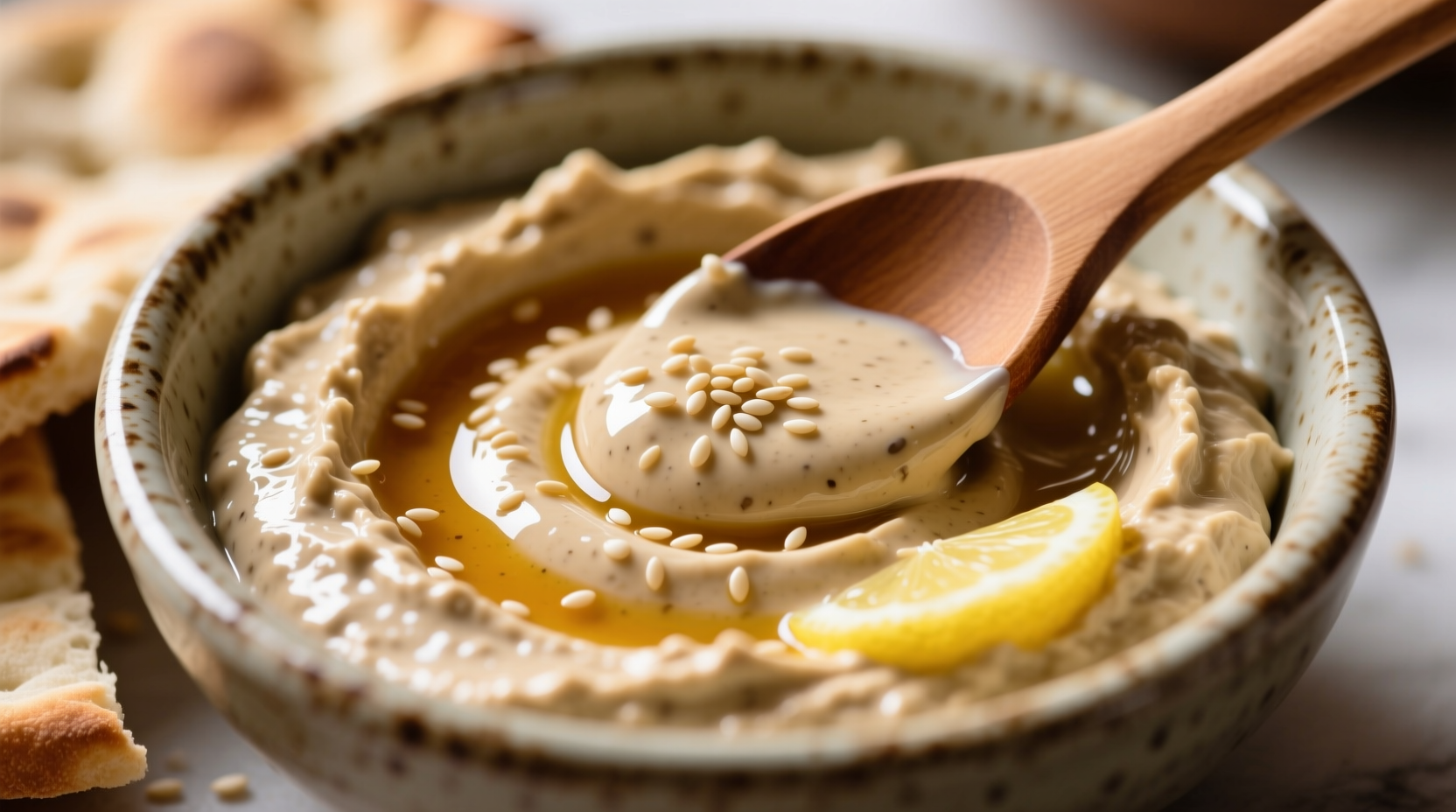Curious about that creamy, beige sauce drizzled over your falafel? Understanding what tahini sauce tastes like unlocks its culinary potential. This Middle Eastern staple transforms from simple sesame paste into a versatile flavor powerhouse when properly prepared. Let's explore exactly what to expect from authentic tahini and how its taste profile enhances your cooking.
The Complete Flavor Breakdown of Tahini Sauce
When you dip your spoon into quality tahini, you'll experience a sophisticated interplay of flavors that evolves as it hits your palate. The initial impression is distinctly nutty—reminiscent of roasted almonds or peanut butter but with more complexity. Unlike peanut butter's sweetness, tahini offers earthy undertones similar to cocoa or coffee beans, followed by a subtle bitterness that balances the richness.
Texture plays a crucial role in tahini's sensory experience. Properly emulsified tahini should feel luxuriously smooth with a velvety mouthfeel that coats the tongue without graininess. When mixed with water, lemon juice, or garlic to create sauce, it transforms into a silky consistency that clings perfectly to vegetables, meats, or bread.
What Influences Tahini's Flavor Profile
Several factors determine how tahini sauce tastes in your kitchen:
- Sesame seed quality: Hulled vs. unhulled seeds create dramatically different flavor experiences
- Roasting level: Lightly toasted seeds yield milder flavor; deeply roasted creates intense nuttiness
- Freshness: Tahini oxidizes over time, developing stronger bitter notes
- Added ingredients: Lemon brightens flavors while garlic adds pungency
- Emulsion technique: Proper water incorporation prevents separation and bitterness
According to culinary research from the USDA Food Composition Database, sesame seeds contain natural compounds like sesamol and sesamin that contribute to tahini's distinctive flavor chemistry. These compounds create the characteristic roasted notes that distinguish tahini from other nut butters.
Tahini Taste Compared to Similar Ingredients
| Ingredient | Primary Flavor Notes | Texture Comparison | Best Culinary Uses |
|---|---|---|---|
| Tahini Sauce | Nutty, earthy, subtle bitterness | Smooth, creamy, emulsified | Dips, dressings, sauces, baking |
| Peanut Butter | Sweet, roasted, sometimes salty | Thick, sometimes oily | Sandwiches, desserts, satay |
| Hummus | Chickpea, garlic, lemon | Chunky to smooth | Dips, spreads, sandwiches |
| Almond Butter | Mildly sweet, delicate nuttiness | Smooth but less creamy | Breakfast, smoothies, baking |
How Tahini's Flavor Transforms in Cooking
Understanding what tahini sauce tastes like when cooked versus raw helps maximize its potential. When used raw in dressings or dips, tahini delivers its full nutty complexity with pronounced earthiness. Cooked applications mellow the bitterness while enhancing roasted notes—perfect for sauces that accompany grilled meats or roasted vegetables.
Chef's tip: Always "wake up" your tahini with lemon juice and a pinch of salt before using. This simple step balances the natural bitterness and enhances the nutty flavors. For the creamiest texture, gradually whisk in ice-cold water until you achieve your desired consistency.

Practical Applications Based on Flavor Profile
Now that you know what tahini sauce tastes like, here's how to use it effectively:
- Mild-flavored tahini (lighter roast): Best for desserts, smoothies, and delicate salad dressings
- Medium-roast tahini: Ideal for everyday sauces, hummus, and as a sandwich spread
- Dark-roast tahini: Perfect for robust dishes like grilled eggplant or hearty stews
When substituting tahini in recipes, remember its unique flavor profile differs significantly from other nut butters. While peanut butter brings sweetness, tahini contributes earthiness that complements Mediterranean and Middle Eastern flavors exceptionally well.
Preserving Tahini's Best Flavor
To maintain optimal taste, store tahini in an airtight container in the refrigerator after opening. High-quality tahini should remain smooth without separation—stir thoroughly before each use. Properly stored tahini maintains its delicate flavor balance for 3-6 months, while poorly stored batches develop stronger bitter notes as the oils oxidize.
For the most authentic tahini sauce flavor experience, seek out freshly made varieties from Middle Eastern markets or specialty grocers. Commercial brands often contain stabilizers and additional oils that alter the natural taste profile.
Frequently Asked Questions
Why does my tahini taste bitter? Bitterness comes from over-roasted sesame seeds or improper emulsification. High-quality tahini should have only subtle bitterness balanced by nuttiness. Adding lemon juice and salt typically counteracts excessive bitterness.
Does tahini taste like peanut butter? While both are nut-based spreads, tahini has a distinctly earthier, less sweet profile with subtle bitterness compared to peanut butter's pronounced sweetness and roasted notes.
How can I improve store-bought tahini's flavor? "Wake up" store-bought tahini by whisking in fresh lemon juice, a pinch of sea salt, and ice-cold water until smooth. This balances flavors and creates the ideal sauce consistency.











 浙公网安备
33010002000092号
浙公网安备
33010002000092号 浙B2-20120091-4
浙B2-20120091-4